Innovators in RDF: An Inventor, a Code Writer, and a Fox Meister
by Joe Moell KØOV
From my Homing In column in the Spring 2010 issue of CQ-VHF Magazine
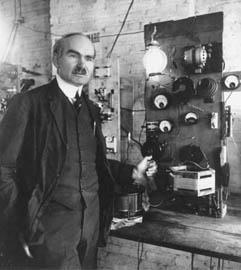 "I know you share my oft-expressed wish that we might live until the 21st century, just to observe the state of radio and television then." Those were the words of radio pioneer Lee de Forest on a Sunday afternoon nationwide radio program in March 1941. "Startling changes are in store," he continued, "but I have a hunch that the little grid will be found in our radio and amplifier tubes even then."
"I know you share my oft-expressed wish that we might live until the 21st century, just to observe the state of radio and television then." Those were the words of radio pioneer Lee de Forest on a Sunday afternoon nationwide radio program in March 1941. "Startling changes are in store," he continued, "but I have a hunch that the little grid will be found in our radio and amplifier tubes even then."
De Forest (pictured at right) has been maligned by some for not fully understanding the physics behind his Audion, the first triode tube.[1] But there can be no doubt that his fragile glass bottle with wires helped make it possible for him to achieve a succession of "firsts" in electronic communication. Radio telegraphers at a the Brooklyn Navy Yard near his laboratory were startled to hear the William Tell Overture on their receivers amid the dits and dahs they were copying from ships at sea, as de Forest became the first to play phonograph records over the air. He also made the first sports broadcast, his voice sending the results of Sandusky, Ohio yacht races fourteen miles from a boat on Lake Erie to the shore.
Like many inventors, de Forest suffered rejection and ridicule. Even though his Audion receiver was more sensitive than the crystal detectors then in use on battleships, the US Navy refused to procure it because it required a battery, which might spill acid on the sailors as the ship swayed. The US government sued him in 1912 for selling stock in his Audion company, saying in court that his claim of a device like an incandescent lamp that could both transmit and receive radio waves was impossible[2] and belittled the work of the great Edison.
De Forest's appearance on that NBC show was about nine months before the USA entered World War II. He didn't yet know the role that the gridded tube would play in radar displays and in television, nor about the microwave transmitting tubes that would be developed for the same purposes and would still be in wide usage today. Solid-state amplifiers, switches and flat screens predominate in most consumer products on the market now, but for the utmost in simplicity, there is still a place for the vacuum tube. I continue to use my home-built cathode-ray bearing display on some of the local mobile transmitter hunts.
One of de Forest's many interests was radio direction finding (RDF). Before he invented the Audion, he submitted a patent application for improvements in wireless telegraphy that took advantage of the directional properties of multiple-wavelength antennas.[3] He noted that straight end-fed horizontal wires of 200 feet to a quarter mile in length have bidirectional gain in the direction of the wire orientation. He also noted that long conductors such as telegraph wires and railroad tracks would guide these low-frequency radio waves.[4]
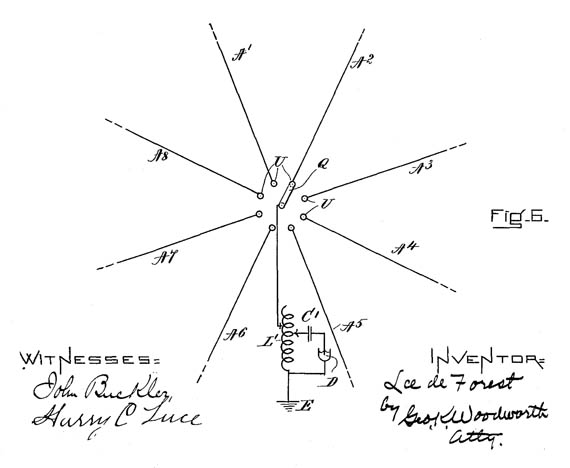
Is this the first electrically rotated radio direction finding antenna? Lee de Forest received a US patent for it in June 1914.
De Forest's patent, which was not issued until eight years after his filing, claimed that multi-element directional transmitting and receiving antennas as well as grounding to railroad tracks would "increase the efficiency of transmission of electromagnetic waves over land and increase the efficiency of duplex working." Not bad for someone who didn't have the benefits of sensitive field-strength meters, antenna ranges and NEC software. It is unclear whether he actually built a switched antenna receiving set for the long wavelengths in use then, but his concept is very much like military microwave RDF systems of today, as well as the switched-antenna amplitude-based RDF method that I described in my last column.
Foxhunting -- Now There's an App for That
A century ago, innovators used components such as triodes, capacitors and transformers to make new products. Today, the building blocks are often subsystems such as GPS engines, camera boards and smart phones. Software tools are now as important as hardware tools. Computerized plotting and triangulation of RDF bearings has been around for a few years, but FoxHunt,® a new iPhone application, makes it possible to do it all on foot. Its creator is Bob Iannucci, W6EI, a MIT-trained engineer and computer scientist.
Among his many activities, Dr. Iannucci is founder of RAI Laboratory, which produces the RadioPort® USB sound card interface for hams. He got the idea for FoxHunt when he and his wife Susan, W6SJI went with friends on their first mobile transmitter hunt with the San Francisco Bay T-hunt group. It was supposed to be an easy one that they could do with handi-talkies, hand-held yagi antennas and paper maps.
"Even though we got the magnetic declination right, we made the error of assuming that straight-up on the map was true north," Bob wrote. "It was actually about 30 degrees off of true north. This caused us to 'spiral in' toward the fox because all of our bearing lines were off by 30 degrees. We never found it.
"I realized that my iPhone 3GS could do a better job of keeping track of all the bearings than I could," Bob continued. "It has a compass, GPS, Google Maps and a good set of programming tools. Within two weeks, I had the app coded and tested."
The present version of Bob's program doesn't interface directly with radios or RDF antennas. It's just a very simple way for anyone to triangulate bearings from multiple locations and display the bearing intersections on Google Maps. After getting a bearing with his or her RDF system, the user looks in that direction while holding the iPhone directly in front. The phone's GPS engine and internal compass determine location and azimuth, then the program puts a bearing ray on the display map. When multiple bearings are entered, the best triangulation is computed and displayed, as shown in the illustration.
W6EI explains that you can give the bearings different weights, based on your confidence of their accuracy. The app will take this into consideration in estimating the fox's position. From the list of previously taken bearings, you can select any one and its line will turn red. Then you can edit its perceived quality rating (number of stars) or tell the triangulation routine to ignore it.
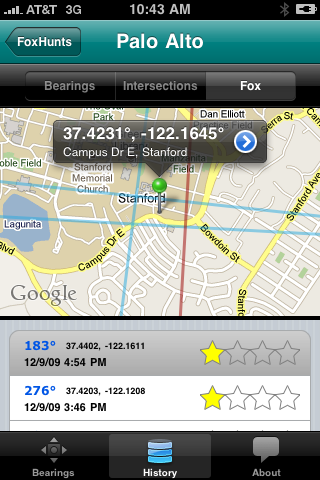
Triangulated bearings on the screen of an iPhone with the FoxHunt® application. There are four bearings; the selected one is red. The program makes a best estimate of the fox location (the green pushpin), based on the confidence level given to each bearing.
Bob says that on his first hunt with his new app, its triangulation predicted the hidden T location to within 100 feet from a distance of ten miles. That's a bit too good to be true, considering that this would require each bearing to be accurate within a tenth of a degree. Even if there are no signal reflections, you can expect your results to vary from that, depending on the pattern of your RDF antenna and how well you can sight your bearings from the antenna boom while looking at the screen of the phone. But the app corrects for magnetic declination, keeps you from making math and plotting errors, and is definitely "cool."
Since it was first offered on December 21, FoxHunt has been downloaded 489 times by iPhone 3GS owners in the USA and 686 outside our borders. Some of them are hams, while others are in law enforcement and professional search-and-rescue work. Bob welcomes suggestions for improvement as he plans his next version. "The current app is free but supported by advertising," he says. "The new Pro version will likely be ad-free but will bear a modest price tag."
W6EI continues, "I am considering a teaming feature for sharing bearing info between phones, an augmented-reality feature that will overlay bearing and intersection information on the view from the iPhone's camera, and the capability to manually enter bearings by the numbers. This may enable those with iPod Touch and older iPhones to use at least some of the features of FoxHunt."
Bob says it would be easy to develop an electrical bearing transfer interface between the iPhone and RDF sets, whether Dopplers or rotating antenna azimuth encoders. He has also dropped some hints about designing and producing a high-tech Doppler RDF unit of his own design to work with FoxHunt. If you are interested in being a beta tester for new products from RAI Laboratory, make contact via the RAI Web site.
International rules forbid GPS positioning and mapping for participants in formal Amateur Radio Direction Finding (ARDF) contests. Competitive radio-orienteers are expected to do it the old-fashioned way, with paper maps supplied by the course-setters and their own hand-held compasses. Expect the organizers of championship ARDF events to forbid the carrying of iPhones by competitors from now on.
Foxhunting in Music City
Hidden transmitter hunting has come to central Tennessee in a big way. Members of the Williamson County Amateur Radio Emergency Service (WCARES) are learning about the sport and developing their skills under the leadership of Tim Kreth, AD4CJ, a cardiologist in Brentwood. "I've been a ham for 15 years or so and have always been interested in this," he told me. "So I mentioned it to the guys and they said, 'OK, you're in charge.' They call me the Fox Meister."
Tim is justifiably proud of WCARES, saying, "We have a little over 160 members. We've been very busy with a six-week class for Technicians licenses with thirty students. I think 22 have passed already. We had ten students who took our class for General upgrade and I think five have passed their tests so far.
"We really encourage our young hams. There is a club net every Monday night that gets 50 to 75 check-ins. For a half-hour prior to that, there is a youth net that is organized by a couple of adults, but we let the youngsters be Net Controls. We have a really great club communications system with five linked ham repeaters covering middle Tennessee. When one of the youngsters announces his or her presence there, almost every time an adult will come up to chat within 20 seconds."
Because of the large number of youth, WCARES has only been doing on-foot foxhunts instead of hunts in cars. Starting with a couple of foxboxes to find, the club is now ready to do five-fox hunts under international rules. "We don't have a fixed date and time for our hunts," Tim explains. "It's whatever my schedule will allow.
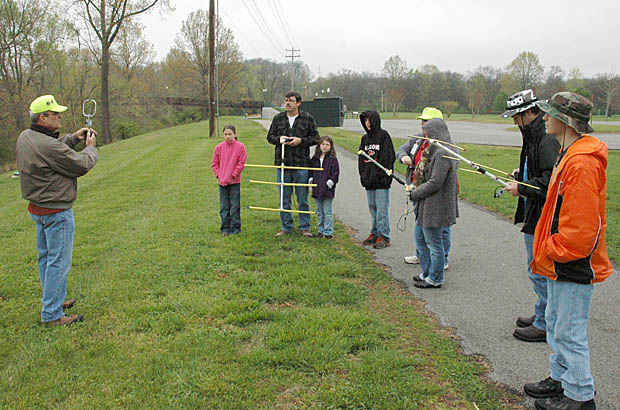
Tim Kreth, AD4CJ teaches direction-finding techniques to newcomers in the Nashville area. (Photo by Craig Lamb, N4BAX)
"Six to twelve people show up for each of these hunts, so it's really a lot of fun. We've had a big building effort for two-meter tape measure yagis and I have three of them that I let people borrow if they haven't built theirs yet. Some use loop antennas instead. Both active and passive RF attenuators are popular. For about twenty minutes before each hunt starts, we'll explain foxhunting techniques to those who haven't done it before. More often than not, the experienced adults will go out with the first-timer youths to help them learn the ropes."
With plenty of experience in signal tracking, WCARES members were ready to jump in when interference kept local officials from using the Linked Emergency Telecommunication System (LETS Talk), a new public safety voice communications network that will eventually provide interoperability over the entire state of Tennessee. "The LETS Talk repeater for Williamson County is actually in Davidson County," says Tim. "It's on a hill in downtown Nashville, about 25 miles north of our county's Emergency Management Agency (EMA) offices. A dead carrier on 156.015 MHz was holding up that node, so it had to be disconnected from the rest of the network.
"The EMA people know us very well, so they called us and asked if we could help find the problem. Gary Heddon, W8JFP; Randy Armour, KI4LMR and I started at the hill. Phil Sherrod, W4PHS had written a computer program for triangulation, so he was at a local headquarters spot. Each of the rest of us had RDF gear and a hand-held GPS unit, so we could transmit our bearings and exact locations to Phil.
"We took our readings at the affected repeater, where the signal was 10 dB over S9. Then we drew a circle on the map five miles out and we spread out at 120 degree angles from there. None of us could hear it there, so we moved in to just 2.5 miles away and we were all able to pick up the carrier again. W4PHS plotted it and the bearings intersected at a Highway Patrol office, only a third of a mile away from the hill with the affected repeater. When we got there, we used our yagis and loops to pinpoint it. We were able to tell exactly which of the six antennas on the pole was the one from which the carrier was coming.
"We knocked on the door of the Highway Patrol dispatch office that Sunday afternoon and told them that they had a stuck radio interfering with LETS Talk. One dispatcher immediately said to the other, 'I wonder if that's why we've been having trouble with our communications!' When they came in Monday morning, the Highway Patrol technicians found a backup VHF radio that was keyed down."
Tim says that the triangulation program by W4PHS predicted the actual stuck transmitter location to within a few dozen feet. That's possible, since it was quite close and its antenna was up on a high pole, giving reflection-free bearings to the hunters. Phil's program doesn't have the street mapping features of W6EI's FoxHunt, but if the bearings and user locations are accurate and correctly entered, the triangulation will be right. "He used the same program for one of our hunts in the park," says Tim. "The triangulation was a quarter-mile off because one of the guys hid his fox next to a chain link fence!"
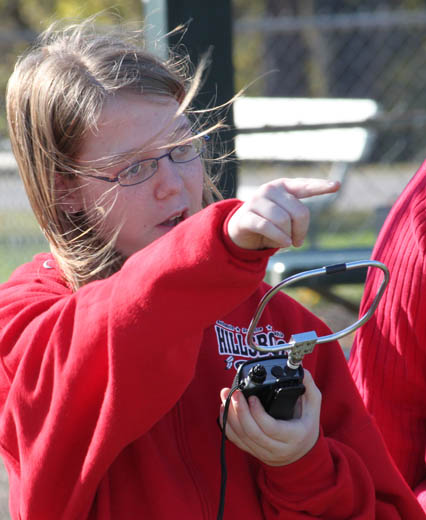
Clara Hedden, granddaughter of Gary Hedden, W8JFP, learns about ARDF bearing-taking at a foxhunt of the Williamson County Amateur Radio Emergency Service. (Photo by Dave Mann, N4CVX)
FOOTNOTES
[1] De Forest's patent application vaguely mentions a "gaseous medium" inside the tube and states that "... the explanation of this phenomenon is exceedingly complex and at best would be merely tentative, I do not deem it necessary herein to enter into a detailed statement of what I believe to be the probable explanation." Edwin Armstrong later showed by measurement that the triode's grid-to-filament voltage controls the flow of electrons from filament to plate and that a high vacuum is better than gas in the envelope.
[2] "Even a man cannot talk and hear with the same organ," sneered the prosecuting attorney. De Forest was eventually acquitted, but the judge urged him to "get a garden variety of job and stick to it."
[3] From US Patent 1,101,533: "... the objects of my invention are to provide transmitting and receiving systems whereby the radiation of electromagnetic signal waves may be concentrated in a definite signal direction and whereby the general direction from which the electromagnetic signal waves which operate a receiving device emanate may be determined ..."
[4] From US Patent 1,101,533: "I have discovered that all longitudinal cross-country conductors, such as railway tracks and masses of telegraph or telephone wires act as wave-chutes and lead off the waves in the direction in which they extend, thus draining the ether of the wave energy in their immediate neighborhood. Thus if a transmitting system ... is operated in the immediate vicinity ... the maximum field of force will be created in the direction of said track or line wire system."
© 2010 Joseph D. Moell. All rights reserved.

 Go to the Homing In magazine column index
Go to the Homing In magazine column index
Back to the Homing In home page
This page updated 29 April 2015
 "I know you share my oft-expressed wish that we might live until the 21st century, just to observe the state of radio and television then." Those were the words of radio pioneer Lee de Forest on a Sunday afternoon nationwide radio program in March 1941. "Startling changes are in store," he continued, "but I have a hunch that the little grid will be found in our radio and amplifier tubes even then."
"I know you share my oft-expressed wish that we might live until the 21st century, just to observe the state of radio and television then." Those were the words of radio pioneer Lee de Forest on a Sunday afternoon nationwide radio program in March 1941. "Startling changes are in store," he continued, "but I have a hunch that the little grid will be found in our radio and amplifier tubes even then."





